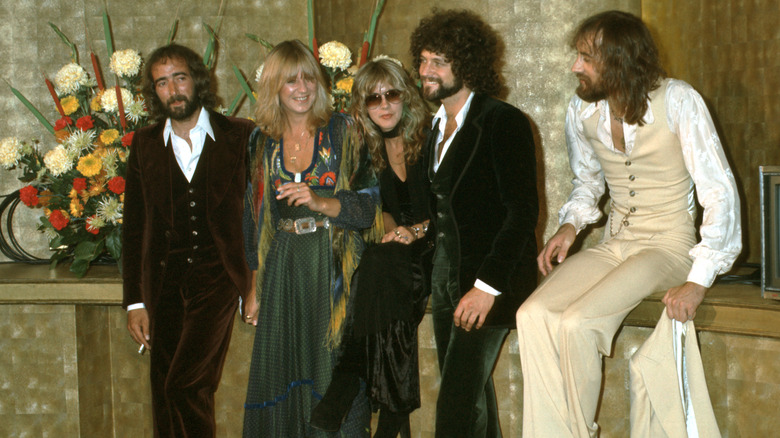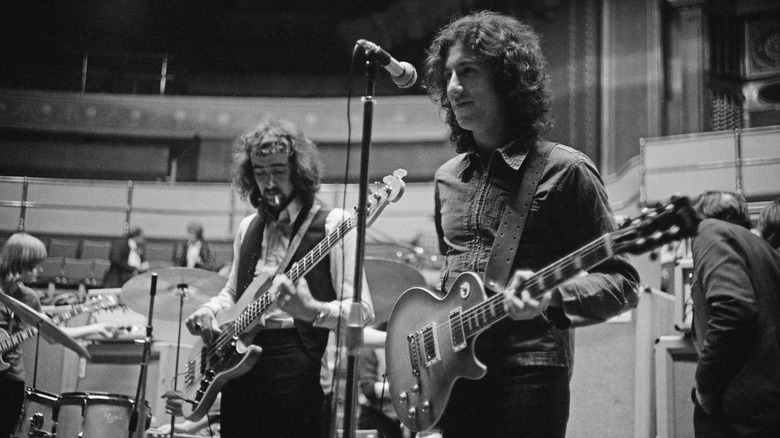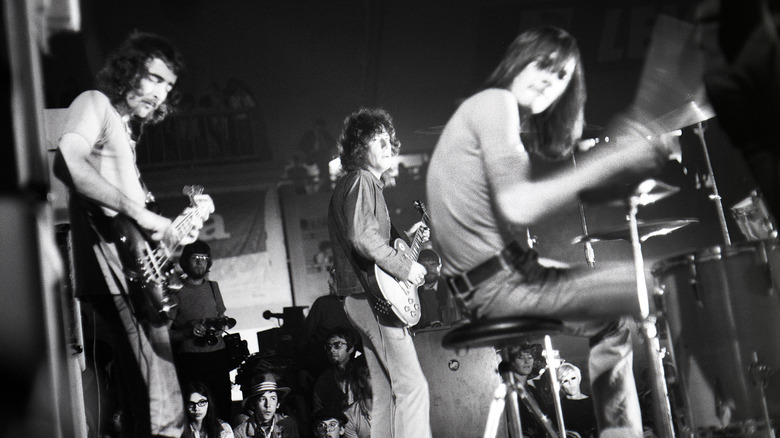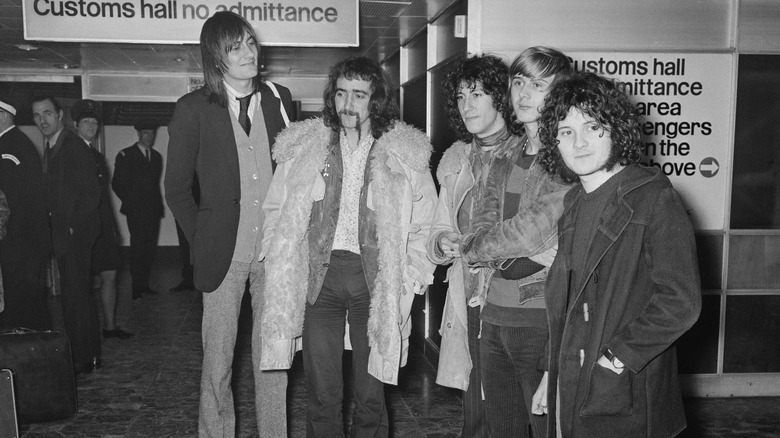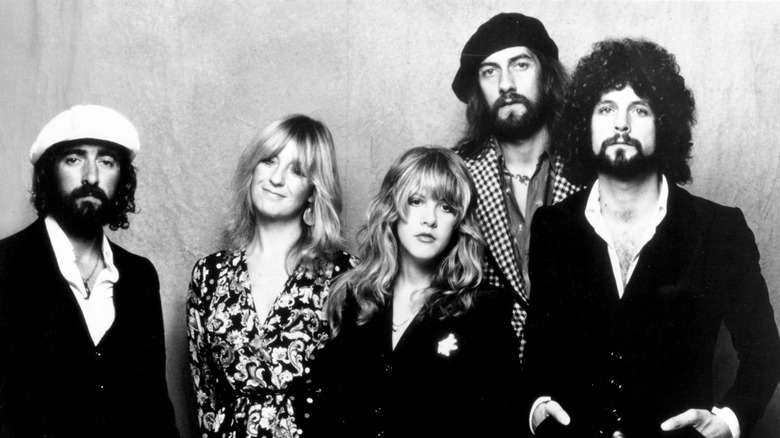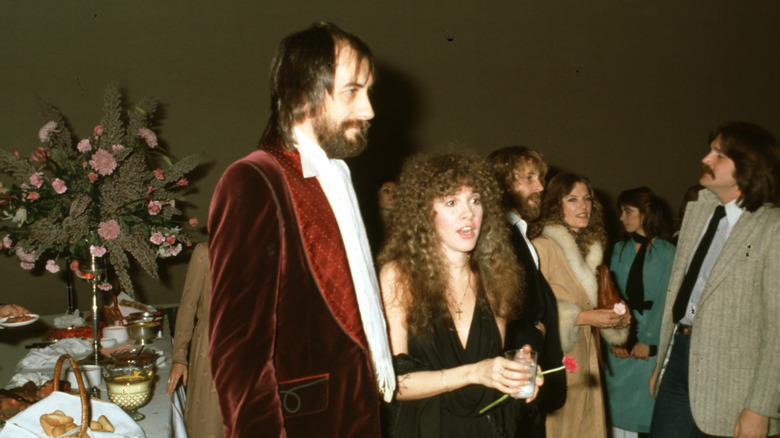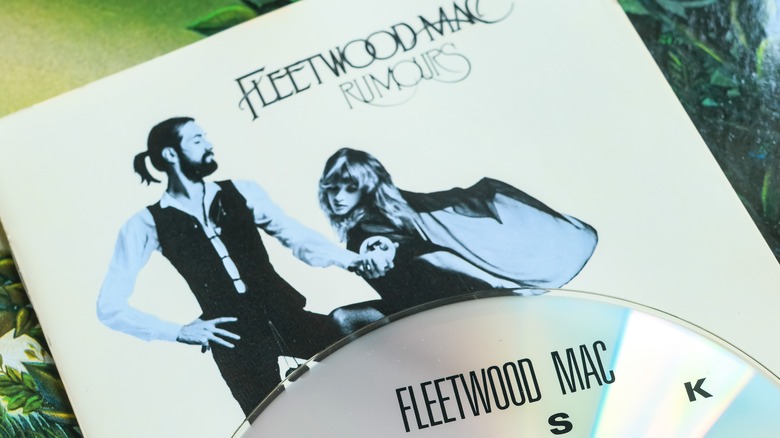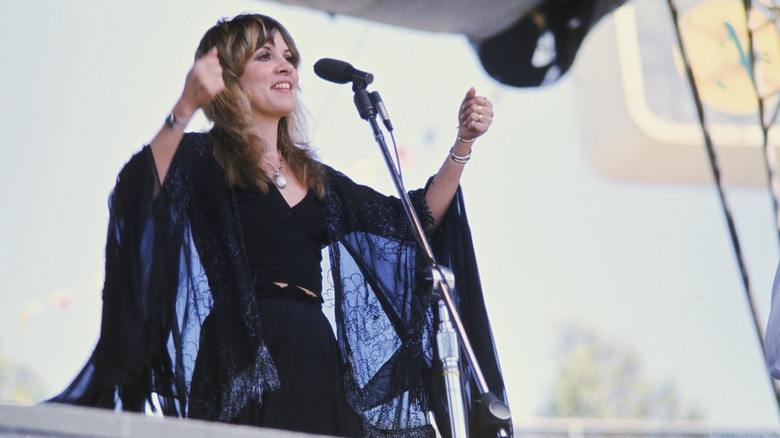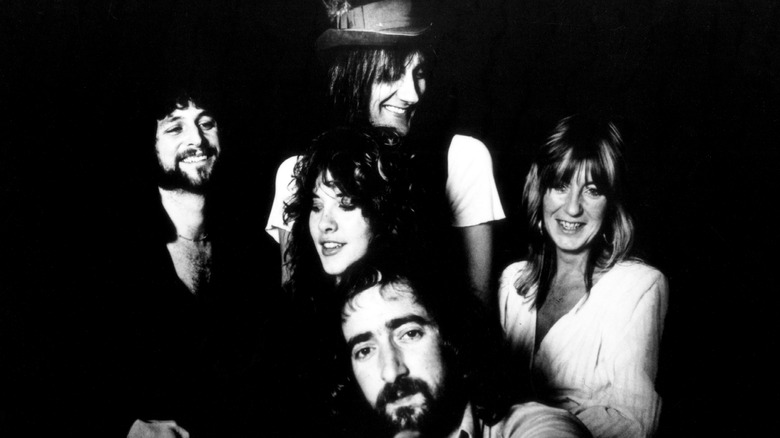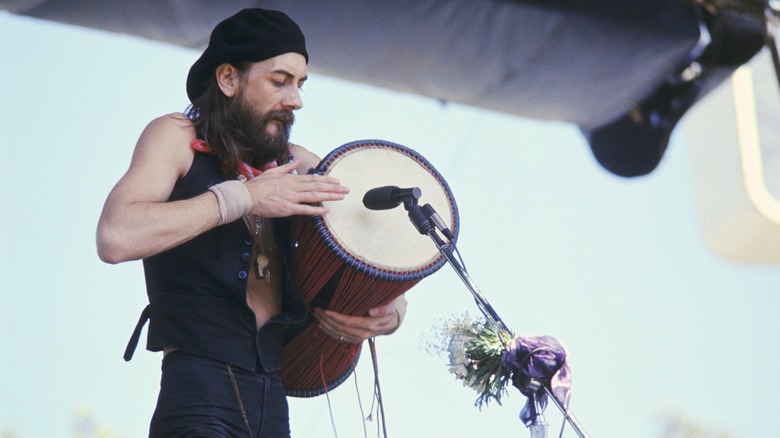Fleetwood Mac: Essential Facts For Every Fan
Fleetwood Mac is one of those bands that doesn't need much of an introduction. Boasting some serious songwriting chops, a slew of era-defining songs, and a plethora of drama and partying, the band catapulted to stardom in 1977 with their iconic album "Rumours," which became one of the most successful records of its time (via Billboard). The most famous version of the band's lineup, consisting of Stevie Nicks on vocals, Lindsey Buckingham on guitar, John McVie on bass, Christine McVie on the keyboard, and Mick Fleetwood on drums, rocked and rolled their way to the top — but the journey didn't come without its challenges.
Breakups, makeups, and, of course, an incredible passion for music helped pave the path that put Fleetwood Mac on the rock 'n' roll map. The band's highs and lows are widely reported, but even so, there are some things that even the biggest Fleetwood Mac fans may not know. For instance, the band didn't even begin in the United States. To go back to the band's roots, we'll have to take a trip across the pond.
Fleetwood Mac was formed in London back in 1967
Many people associate Fleetwood Mac with the late 1970s rock era, but the band officially got its start across the pond in the 1960s. According to Britannica, the band was formed in London in 1967 with four members: Peter Green, John McVie, Mick Fleetwood, and Jeremy Spencer. As AllMusic explains, Green, McVie, and Fleetwood were previous members of an iconic blues act John Mayall & the Bluesbreakers (Green actually replaced Eric Clapton on guitar), but they decided to go their own way and start a band of their own, adding Spencer to the lineup.
While the Fleetwood Mac sound we know today is a beautiful mix of rock, pop, and folk, the early Fleetwood Mac lineup found success with its British blues sound. According to Discogs, their debut album "Fleetwood Mac" was a hit within the U.K. blues sphere, catapulting the band to success. However, as AllMusic reports, the record didn't make a big splash in the United States.
Mick Fleetwood and John McVie didn't pick the band's name
You have to admit: Fleetwood Mac is a pretty cool name for a rock 'n' roll band. So who exactly came up with it? Well, if you guessed it was Mick Fleetwood and John McVie, you'd be mistaken. According to The Washington Post, it was Peter Green who came up with the name by combining Fleetwood and McVie's last names.
It's an interesting move, if you think about it. Green was a well-known and respected guitarist at the time of Fleetwood Mac's formation, so he could have easily thrown his own recognizable name in the mix. However, according to NPR (which cites the documentary "Man of the World: The Peter Green Story"), Fleetwood said that not including his own name in the band's name showed his commitment to being part of the group instead of putting himself in the spotlight.
Peter Green left the band to change his life — and Jeremy Spencer left to join a cult
It's no secret that Fleetwood Mac's lineup has changed a number of times throughout the years, but what you may not know is that the first big lineup change came in 1970. According to Ultimate Classic Rock, that's when Peter Green left the band amid issues with his mental health; the BBC reports that he was later diagnosed with schizophrenia. According to The New York Times, he was also taking LSD at the time he left Fleetwood Mac and was inspired to change his life.
Green wouldn't be the only original Fleetwood Mac musician to leave the band in the early '70s. According to The Guardian, the band's other guitarist, Jeremy Spencer, parted ways with the group in 1971 while touring in the U.S. Spencer reportedly stepped out one day in Los Angeles and went missing for days; he was eventually found at the headquarters for the Children of God cult. The Guardian reports that he left the band and joined the cult with his family.
If you or someone you know is struggling with mental health, please contact the Crisis Text Line by texting HOME to 741741, call the National Alliance on Mental Illness helpline at 1-800-950-NAMI (6264), or visit the National Institute of Mental Health website.
Lindsey Buckingham and Stevie Nicks didn't join the band until 1974
Now, fast forward to New Year's Eve 1974. It was at this time that Mick Fleetwood asked Lindsey Buckingham to join the band (via Ultimate Classic Rock). The group was looking for a new guitarist — at the time, the band consisted of Fleetwood, John McVie, and Christine McVie, who joined the band in 1970 (via Variety.) Buckingham arranged it so that both he and Stevie Nicks, his girlfriend and music partner, would join the band.
Buckingham and Nicks had been making music together long before the opportunity to join Fleetwood Mac came along. According to People, the duo first met in the late '60s as high school students. The Los Angeles Times reports that the two became music collaborators and eventually started dating, moving to Los Angeles together in 1972. They were a duo called Buckingham Nicks and even put out a self-titled album in 1973 (via Discogs). As NME reports, Nicks and Buckingham first appeared as members of Fleetwood Mac on their 1975 album "Fleetwood Mac" — two years before their album "Rumours" launched them to superstardom.
Mick Fleetwood and Stevie Nicks had an affair
It's widely reported that each member of Fleetwood Mac was experiencing relationship woes while recording "Rumours." According to Biography, John and Christine McVie were close to divorcing, Lindsey Buckingham and Stevie Nicks called it quits, and Mick Fleetwood found out his wife was having an affair with one of his friends. Yeah, that's a lot of heartbreak in one studio. Something fans may not know about the romantic inner workings of Fleetwood Mac? The fact that Nicks and Fleetwood had a brief affair (via Far Out Magazine).
According to Rolling Stone, the spark of attraction between Fleetwood and Nicks was lit during a Rolling Stone cover shoot, which called for the duo to snuggle next to one another in bed (along with their other bandmates). The affair began during the "Rumours" tour in 1977 — a time when Nicks was seeing Eagles singer Don Henley and Fleetwood was married (via Audacy). The affair didn't last long, and Nicks herself called it "doomed" and said that it "caused a lot of pain" in an interview on "Oprah's Master Class." Fleetwood, however, said he and Nicks had a "very bright moment" with their timely affair (via Fox News).
Those balls hanging from Mick Fleetwood's legs on the Rumours cover are actually toilet chains
"Rumours" is an iconic album for Fleetwood Mac, so it's only fitting that its cover art is equally as iconic — and a bit odd. According to Far Out Magazine, the cover shows Stevie Nicks and Mick Fleetwood hand-in-hand, with Fleetwood propping his leg up ... and your eye can't help but wander to those wooden balls. A natural question is, "Huh, what are those balls between Fleetwood's legs?" Well, turns out, they're not just some random prop that draws the eye down south.
As Rolling Stone reports, the balls are actually toilet chains that Fleetwood yanked out of a bathroom during an early Fleetwood Mac performance. He hung them between his legs for a laugh, but they actually became part of his act — serving as funky good luck charms that he's carried to almost every Fleetwood Mac show.
Stevie Nicks did so much coke that it burned a hole in her nose
Every member of Fleetwood Mac embraced the rock and roll lifestyle. According to Rolling Stone, Stevie Nicks admitted that each member of the band had an addiction to drugs, but at one point, she had the worst cocaine habit. As Far Out Magazine reports, Nicks' coke habit started as a recreational activity but grew into an addiction by the time "Rumours" came about. Getting launched into the rock 'n' roll stratosphere — combined with a grueling touring schedule and a deep sense of loneliness — didn't help matters, either.
Nicks' cocaine habit continued into the '80s, and it caused a hole to form in her nasal cartilage (via Biography). In an interview for "Oprah's Master Class," Nicks said the doctor explained that, with that hole, her next bump could very well be her last. Biography explains that Nicks went to rehab in 1986, which helped her kick the coke habit. Nicks has been very open about her coke addiction — during "Oprah's Master Class," she admitted that cocaine was, at one point, the first thing she thought about in the morning and the last thing she thought about before turning in for the night. She also said she saved herself from her addiction and got through scary moments on her own (via Vanity Fair).
If you or anyone you know is struggling with addiction issues, help is available. Visit the Substance Abuse and Mental Health Services Administration website or contact SAMHSA's National Helpline at 1-800-662-HELP (4357).
Stevie Nicks didn't want to record a solo album until 1981 because she loved being part of a band
Given Fleetwood Mac's success and Stevie Nicks' undeniable talent, it was only a matter of time before she went solo. However, according to Nicks herself, she didn't even think about going solo until 1981 (via Vanity Fair). According to Vanity Fair, Nicks explained to Tim McGraw that she loved being in a band — and that even when she did decide to embark on a solo career, she didn't want to leave Fleetwood Mac. Nicks did eventually go solo and released her first solo record, "Bella Donna," in 1981 (via Ultimate Classic Rock). Ultimate Classic Rock reports that "Bella Donna" was a chance for Nicks to release songs she had written while in Fleetwood Mac. "Bella Donna" featured hits like "Edge of Seventeen" and "Leather and Lace," a duet between Nicks and Don Henley (via Discogs).
Stevie Nicks and Christine McVie shared a special bond
Stevie Nicks and Christine McVie were the two women of Fleetwood Mac — Nicks was on vocals, and McVie was on the keyboard and also sang. Being the only two women in a band that was thrust into stardom, Nicks and McVie banded together and formed a close bond. According to Harper's Bazaar, McVie admired her and Nicks' differences, and it was those differences that bonded them. McVie explained that she admired Nicks' talent and dedication to her career, especially since McVie herself eventually led a more of a low-key life outside of the band.
Nicks has gushed about McVie, too. As The Guardian reports, Nicks called McVie a best friend, big sister, and mentor. Nicks also told The Guardian that they made a pact in the early days to stick together and be treated as equals in the male-dominated rock business. After making a promise like that, it's no wonder the two ladies of Fleetwood Mac formed such a great friendship.
One of Fleetwood Mac's songs became a future president's campaign tune
By early 1993, the lineup that sent Fleetwood Mac to rock legend status had parted ways. According to Ultimate Classic Rock, Lindsey Buckingham left the band in 1987, with Christine McVie and Stevie Nicks following suit in 1990. However, just a few years later, the band would find themselves reunited by politics ... well, sort of.
According to Rolling Stone, a presidential hopeful by the name of Bill Clinton unofficially adopted Fleetwood Mac's tune "Don't Stop" as his campaign song. While Clinton loved the tune (and Fleetwood Mac), his aides weren't too keen on the music choice — but Clinton didn't listen and stuck to his musical guns (via Time). Eventually, the song grew on others just as much as it had on Clinton. He was so fond of the song that he had Fleetwood Mac reunite to play at his first inaugural gala in January 1993, the first time the "Rumours" era lineup had gotten together on stage in about five years (via History).
The band's most famous lineup has reunited twice over the last 25 years
Given the history and talent Fleetwood Mac has, it was only a matter of time before they got their most famous lineup back together. As Rolling Stone reports, Stevie Nicks, Lindsey Buckingham, John McVie, Mick Fleetwood, and Christine McVie reunited in 1997. They released their album "The Dance" that same year (which reached No.1), and they also did an "MTV Unplugged" performance (via Ultimate Classic Rock.)
The next year, in 1998, Christine McVie retired from the band, leaving Buckingham, Nicks, Fleetwood, and John McVie for the lineup. According to Time, the next time the "Rumours"-era lineup reunited was in 2014, when Christine McVie once again returned to the group — marking the second time this lineup officially reunited. She was welcomed back with open arms from both the public and her bandmates, as The Guardian reports.
Lindsey Buckingham was fired from the band in 2018 — and wound up suing them
The Fleetwood Mac lineup went through a change once again in 2018 when Lindsey Buckingham was fired from the band (via Rolling Stone). According to Billboard, Buckingham got the boot amid issues surrounding the band's 2019 tour. It sounds like another Fleetwood Mac bump in the road that led to a departure, but this one was a bit bumpier for the tumultuous rock group. According to People, Buckingham sued the band in October 2018, laying out several accusations, including breach of oral contract. The lawsuit wound up being settled just two months later, in December 2018.
Needless to say, things weren't exactly peachy between Mick Fleetwood and Buckingham after the lawsuit. People reports that the two were estranged for two years after the lawsuit, but they reconciled in 2020 following the death of Fleetwood Mac founder Peter Green. People also reports that Mick Fleetwood would like to make music with Buckingham once again, even if it isn't with Fleetwood Mac.
Lindsey Buckingham put an RV in his driveway because of Stevie Nicks' and Mick Fleetwood's drug use
Picture this: It's 1987, a decade after "Rumours" came out, and Fleetwood Mac is recording their album "Tango in the Night." In true Fleetwood Mac fashion, things aren't exactly peachy in the band. According to Ultimate Classic Rock, Lindsey Buckingham was recording a solo album at the time "Tango in the Night" came about, and he wasn't exactly chomping at the bit to record another album with the band. Alas, he decided to bring some of his solo work to "Tango in the Night" — an album he thought would be his last with the group.
As Louder Sound reports, much of the album's recording happened in Buckingham's home studio, meaning his bandmates — and their party habits — infiltrated his house. Stevie Nicks and Mick Fleetwood were not only using cocaine at this time, but they had worse coke habits than they had while recording "Rumours." Buckingham wasn't impressed with his bandmates' recreational activities, so he put a Winnebago in his driveway so that Nicks, Fleetwood, and the company they kept would have a place to party that wasn't in his home. Talk about a rock n' roll compromise.
Despite the tension at the time of recording, "Tango in the Night" became one of Fleetwood Mac's most successful albums and is a staple record in '80s soft rock history (via Louder Sound).
Mick Fleetwood went bankrupt in the 1980s
Fleetwood Mac was one of the most successful bands of the 1970s, with "Rumours" selling more than 45 million copies worldwide since its release (via Rolling Stone). The band was a hit, but one of its co-founders didn't spend his hard-earned money so wisely.
According to Rolling Stone, Mick Fleetwood filed for bankruptcy in the spring of 1984 — he had more than $3.6 million in debt and only around $2.4 million in assets. It wasn't the rock n' roll lifestyle that drained Fleetwood's bank account, though — Fleetwood himself admitted that making some poor decisions regarding real estate contributed to his financial downfall. That, and a few bad investments.
Bankruptcy is a stressful thing to go through, so you'd think one would avoid it happening again at all costs, right? Turns out, Fleetwood's 1984 bankruptcy was only the beginning. According to The Independent, the musician said he's "lost count" of his bankruptcies over the years ... seriously.
